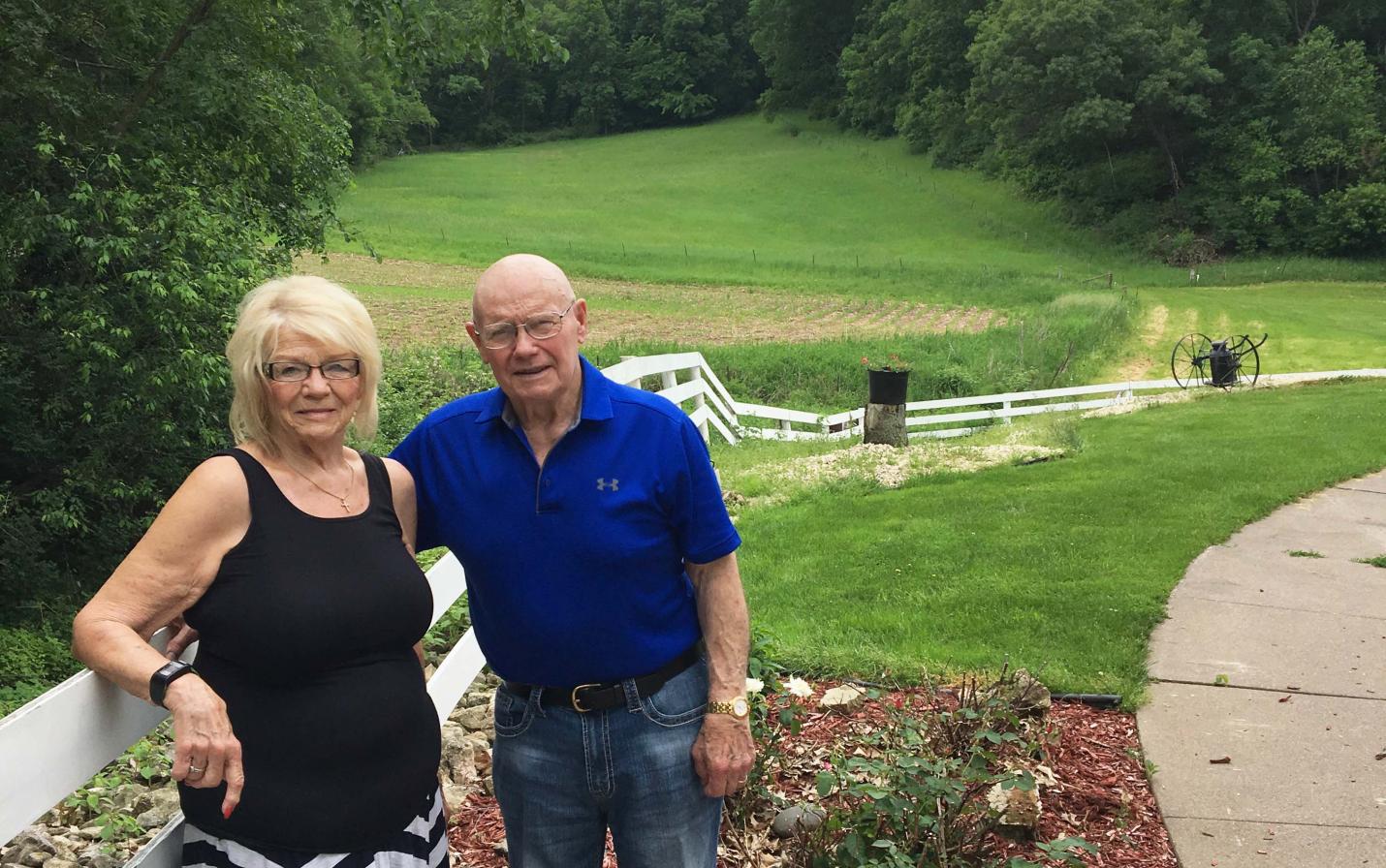
TREMPEALEAU COUNTY, WIS. – J.W. “Bill” and Mary Ann Hein have permanently protected their 360-acre farm in Ettrick Township by way of a voluntary conservation agreement with Mississippi Valley Conservancy. Their action means that the property, which includes two rare groups of plants and their natural environments (also called natural communities), is protected from future development, mining or any other kind of habitat destruction.
The first rare natural community found on the Hein property is oak savanna, which features oak trees open enough at the top to allow grasses and other vegetation grow below them. In southern Wisconsin and the upper Midwest, oak savannas were dominant around the time of European settlement 200 years ago. Now less than one hundredth of one percent of savannas remain. The second rare natural community on the Heins’ property is southern sedge meadow, also known as a wetland. According to the Wisconsin Wetlands Association, three-fourths of Wisconsin wildlife species depend on wetlands. Half of the state’s wetlands have been lost since the late 1800s.
The Heins’ decision to protect their land reflects their love of the property, which began 52 years ago. Bill had just taken a job in Galesville and he and Mary Ann wanted to raise their family in a rural setting. But finding property was easier said than done. When Mary Ann learned about a farm that had just gone on the market, she insisted that they look at the new listing right away—in the dark.
“We bought it with a handshake, not even being able to see what we were buying,” she laughs. “When we went back in the morning, we were so happy. Three months later, the farm next door went up for sale. Even though we had everything invested in the first farm, we bought the second one because we knew we’d never get this chance again. I had prayed for a farm and then things just fell into place. It was in God’s hands,” she says.
Bill and Mary Ann raised four children on the farm, inspiring a love and respect of nature in all of them and in their nine grandchildren, as well. They all enjoy hiking the land and driving ATVs to lookout points to take in the full beauty of the forests, cliffs, wetlands and farmland that is still in production. The wetlands are a sea of purple when the Joe-Pye-weed blooms each summer and bright yellow when the tamaracks put on their show in fall.
The Heins have also seen abundant wildlife on their land, including bears, bobcats and even fishers. Common yellowthroats are drawn to the cattails in the sedge meadow as much as the scarlet tanagers are to the forests. Ovenbirds nest on the ground at the forests’ edges and turkey are abundant. “It makes us so happy to see the healthy wildlife here. Our love of nature and this land is what drove us to protect it,” says Bill.
Diverse Land
The Hein property is located along a 2,000-foot stretch of Hein Creek, with frontage on both sides, and includes adjacent springs in addition to the over 40 acres of sedge meadow lined by other wetlands. The wetlands play an invaluable role in filtering runoff water from adjacent lands. Because the wooded bluffs, wetlands and meadow are visible from nearby roads, the public also can enjoy the scenery. The ridgetop overlooks offer expansive views of the surrounding Beaver Creek watershed.
The property is within the Department of Natural Resource’s Coulee Forest Conservation Opportunity Area of Continental Ecological Significance. Its oak savannas (also known as oak openings) are considered globally imperiled, according to Wisconsin’s wildlife action plan. That means they’re at very high risk of extinction or elimination. The savannas on the Heins’ farm offer an understory of native wildflowers, including bird’s foot-violet and prairie spiderwort, for area bees and butterflies and provide habitat for declining species such as the whippoorwill.
Carol Abrahamzon, executive director of the Conservancy, says the Heins are providing an enduring legacy to future generations. “They’ve worked so hard to take care of this land and now they can rest assured knowing that it will always be protected,” Carol says. The conservation agreement allows the Heins to continue to own and farm the land, sustainably harvest the timber, and live on and enjoy the property.
The Secret Hiding Place
Enjoying the property is easy when there are natural wonders everywhere you look. One is a huge sandstone rock not far from the Hein’s driveway. Fondly called “the secret hiding place,” the rock was off limits to Grandpa Bill (even though he cut the grass there).
Mary Ann says that when the grandchildren were young, they’d head to the secret hiding place and simply look for beauty in anything they found or saw. And if Grandpa got too close, the kids shooed him away while Bill happily played along. “We had such fun in the secret hiding place. That tradition made it all the way through nine grandchildren,” Mary Ann says. Their names are carved in the stone, as are names of others who came before them.
The Heins find deep comfort in knowing that others who come after them will have the same opportunities to develop a respect and love for nature. “It sickens me to see natural habitat destroyed. So much land is lost to concrete. And fracking—we said there’s no way they’re going to do that to this farm. You can’t put back a hill. You can’t replace wetlands. It’s good to know that the land we love will stay this way. Years from now, we want people to see what it was like. Nature does a wonderful job if you give it the chance,” says Bill.